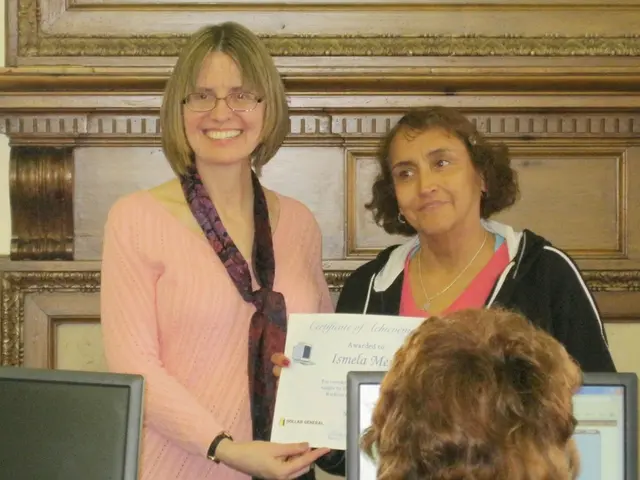Encouraging Small Businesses via the EPA's SBIR Initiative
The Environmental Protection Agency (EPA) Small Business Innovation Research (SBIR) program is a significant initiative that supports small businesses in developing and commercializing novel green technologies. Established in 1982, the program aims to fund innovative solutions that promote environmental sustainability and compliance with regulations[1].
Technologies developed through EPA SBIR funding encompass a wide range of environmental protection innovations, pollution reduction technologies, and sustainable solutions. These funds are often used to create new methods for cleaner energy, waste reduction, or monitoring and controlling pollutants[1].
One example of a successful EPA SBIR project is ASAT Inc., an Oregon-based small business that received an award for their Integrated Stove technology, which improves energy efficiency and reduces emissions[2]. Similarly, Lucid Design Group Inc., a California-based small business, received an award for developing software that drives energy conservation and savings in commercial buildings[3].
Companies that have technologies responsive to this year's topics, such as clean and safe water, air quality, land revitalization, homeland security, sustainable materials management, and safer chemicals, are encouraged to apply[4].
Vaporsens, Inc., a Utah-based small business, is another recipient of EPA SBIR funding. In 2017, they received an award for developing a highly sensitive, real-time sensor for indoor formaldehyde detection[5]. Vaporsens plans to use these funds, along with matching EPA commercialization funding of $100,000, to develop and test prototypes, as well as facilitate commercialization of their indoor air formaldehyde sensor devices[6].
GVD Corporation, a small business out of Massachusetts, used EPA SBIR funding to create a mold-release coating made of high purity polytetrafluoroethylene (PTFE) that improves air quality inside manufacturing facilities[7]. As a result, GVD Corporation partnered with a major automotive parts manufacturer who uses GVD's vapor-deposited PTFE mold-release coatings to streamline tire manufacturing[8].
In addition to these examples, Bridger Photonics, a small business out of Montana, has received multiple EPA SBIR awards for their innovative sensor technologies[9]. During their EPA SBIR project, Bridger Photonics developed a mid-infrared laser for use in a remote CO sensor with high-range resolution for onsite CO monitoring and spatial mapping from a distance[10].
Industrial Microbes, a California-based small business, also received an EPA SBIR award for engineering a microbe that consumes carbon dioxide and methane to produce a chemical used to make synthetic fibers and biodegradable plastics[11].
EPA SBIR companies have secured outside investment and commercial success after receiving funding. For instance, GreenTechnologies, LLC, a small business based in Florida, used EPA SBIR funding to develop and commercialize a sustainable treatment and nutrient recovery process for wastewater[12]. GreenTechnologies' fertilizer, GreenEdge®, is sold commercially across the United States and internationally[13].
The 2021 EPA SBIR Phase I solicitation is open now through August 28, 2020[4]. Since its inception, EPA SBIR has supported 635 individual small businesses across 46 states with over 1,600 awards totaling more than $174 million[14].
In conclusion, the EPA SBIR program is a valuable resource for small businesses seeking to develop and commercialize green technologies that protect and enhance ecosystems. The program's focus on environmental and green technology innovations has led to the creation of new commercializable environmental solutions, as demonstrated by the success stories highlighted above.
[1] EPA. (n.d.). EPA's Small Business Innovation Research (SBIR) Program. Retrieved from https://www.epa.gov/sbir/epas-small-business-innovation-research-sbir-program [2] Oregon State University. (2017, June 27). ASAT Inc. receives EPA SBIR award for Integrated Stove technology. Retrieved from https://news.oregonstate.edu/newsroom/2017/06/27/asat-inc-receives-epa-sbir-award-integrated-stove-technology [3] U.S. Environmental Protection Agency. (2017, December 13). Lucid Design Group receives EPA SBIR award for energy management software. Retrieved from https://www.epa.gov/newsreleases/lucid-design-group-receives-epa-sbir-award-energy-management-software [4] U.S. Environmental Protection Agency. (2020, May 15). EPA's 2021 SBIR Phase I Solicitation is now open. Retrieved from https://www.epa.gov/sbir/epas-2021-sbir-phase-i-solicitation-now-open [5] Vaporsens, Inc. (n.d.). About Us. Retrieved from https://www.vaporsens.com/about-us [6] U.S. Environmental Protection Agency. (2018, June 12). Vaporsens, Inc. receives EPA SBIR award to develop indoor air formaldehyde sensor devices. Retrieved from https://www.epa.gov/newsreleases/vaporsens-inc-receives-epa-sbir-award-develop-indoor-air-formaldehyde-sensor-devices [7] GVD Corporation. (n.d.). GVD Corporation. Retrieved from https://www.gvdc.com/ [8] U.S. Environmental Protection Agency. (2016, September 19). GVD Corporation receives EPA SBIR award for PTFE mold-release coating technology. Retrieved from https://www.epa.gov/newsreleases/gvd-corporation-receives-epa-sbir-award-ptfe-mold-release-coating-technology [9] Bridger Photonics. (n.d.). Bridger Photonics. Retrieved from https://www.bridgerphotonics.com/ [10] U.S. Environmental Protection Agency. (2015, September 30). Bridger Photonics receives EPA SBIR award to develop mid-infrared laser for CO sensors. Retrieved from https://www.epa.gov/newsreleases/bridger-photonics-receives-epa-sbir-award-develop-mid-infrared-laser-co-sensors [11] Industrial Microbes. (n.d.). Industrial Microbes. Retrieved from https://industrialmicrobes.com/ [12] GreenTechnologies, LLC. (n.d.). GreenTechnologies, LLC. Retrieved from https://www.greentechnologiesllc.com/ [13] U.S. Environmental Protection Agency. (2017, March 15). GreenTechnologies, LLC receives EPA SBIR award for wastewater treatment technology. Retrieved from https://www.epa.gov/newsreleases/greentechnologies-llc-receives-epa-sbir-award-wastewater-treatment-technology [14] U.S. Environmental Protection Agency. (n.d.). EPA's Small Business Innovation Research (SBIR) Program: Frequently Asked Questions. Retrieved from https://www.epa.gov/sbir/epas-small-business-innovation-research-sbir-program-frequently-asked-questions
- The Environmental Protection Agency (EPA) SBIR program funds various projects aimed at reducing waste, such as Vaporsens' development of a real-time sensor for indoor formaldehyde detection.
- GVD Corporation, a small business based in Massachusetts, used EPA SBIR funding to develop a mold-release coating that contributes to improved air quality inside manufacturing facilities.
- Bridger Photonics, a small business out of Montana, received multiple EPA SBIR awards for sensor technologies that monitor air quality, specifically carbon monoxide.
- Industrial Microbes, a California-based small business, received an EPA SBIR award to engineer a microbe that consumes carbon dioxide and methane, contributing to the production of chemicals used for creating synthetic fibers and biodegradable plastics.
- GreenTechnologies, LLC, a small business based in Florida, used EPA SBIR funding to develop and commercialize a sustainable treatment process for wastewater, improving water quality both locally and internationally.




